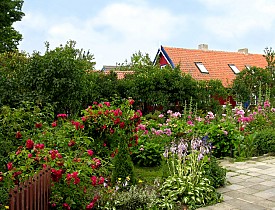10 Tips for Growing Roses
 I know everyone appreciates the aesthetic beauty and the sweet fragrance of a rose. But I'm going to go out on a limb and guess that most people don't know that rose petals, which can be candied or turned into a jam, also have a distinctly fruity flavor. Also, the fruit of the rose plant, called a rose hip, is prized for teas and is high in vitamin C, and the seeds themselves are high in vitamin E. Of course, if you're applying pesticides to your roses, then it's better not to eat them.
I know everyone appreciates the aesthetic beauty and the sweet fragrance of a rose. But I'm going to go out on a limb and guess that most people don't know that rose petals, which can be candied or turned into a jam, also have a distinctly fruity flavor. Also, the fruit of the rose plant, called a rose hip, is prized for teas and is high in vitamin C, and the seeds themselves are high in vitamin E. Of course, if you're applying pesticides to your roses, then it's better not to eat them.
Whichever way you like them, roses are a wonderful plant to have around. Here are some tips for incorporating roses into your garden or yard.
1. Select the right type of rose. Rose plants come in a diversity of forms, from short shrubs to climbing vines. Some are more pest-resistant than others. The flowers they produce range in color, size, scent, and can have many different petal arrangements. For instance, take a look at wild rose varieties—they look very different from your standard garden rose. Choose types that make sense for your garden and your taste.
2. Choose a location with adequate sunlight. For most varieties, at least five hours a day of sun is de rigueur. Early morning sun is better than late afternoon sun. It is cooler and also helps dry off early morning dew, helping prevent fungal disease.
3. Make sure there is adequate drainage. Roses will not survive in overly wet soil. However, keep in mind that you can drain boggy soil or, alternatively, construct raised beds. Planting roses in containers is also an option. If your soil is too dry, you can add organic matter to help it retain moisture. In most climates, roses require regular watering during growing season (a couple times per week), and will need more while they're producing flowers.
4. Like with most other garden plants, select an area that will not be exposed to strong winds. If strong winds are expected, you can plant trees as a wind barrier or build a fence.
5. In terms of soil acidity, roses prefer a pH around 6.5, but many varieties can tolerate a pH range from 5.5 to 7.5. Of course, if your soil is too acid or alkaline, this can always be easily fixed by adding the appropriate soil amendments.
6. Distance plants properly. If you plant them too close to each other or to other bushes or trees, they may fail to thrive and will not produce flowers. That being said, don't hesitate to grow low-lying herbs or other flowers on the bare soil between your roses. Not only can this be a beautiful visual effect, but you can also select plants that will naturally repel pests attracted to roses.
7. If you're planting numerous rose varieties together, plant taller varieties in the center or back of the bed.
8. The best time to plant roses is during the cooler months of spring or early summer. If you don't experience frost during winter in your climate, then you can plant during winter as well.
9. Once your roses are planted and thriving, make sure you deadhead them to keep them producing beautiful flowers. No, I don't mean that you should play them a Grateful Dead album. Deadheading is cutting off the dead flowers before they have a chance to form hips and set seed. Since, from the plant's perspective, its whole purpose is to set seed, then as long as you keep cutting off the dead flowers and preventing seed from setting, the plant will keep producing more flowers in an urgent effort to set seed. It works out quite beautifully. Stop deadheading about six weeks before frosts set in.
10. Make sure you rake up dead leaves and debris from around the base of your roses in fall. It will reduce the chances of disease.
Looking for a Pro? Call us (866) 441-6648

Landscaping Average Costs
Landscapers Experiences

Leaf Removal This Year, More Landscape Work Next Summer

Tree Removal And Backyard Cleanup Make A New House Feel Like Home



